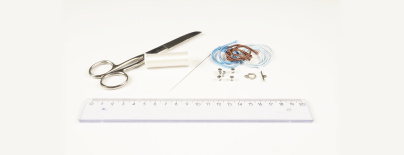Preciosa Ornela presents a new pressed bead from the PRECIOSA Traditional Czech Beads brand, PRECIOSA Pellet™, in combination with the popular braiding technique.
A practical pressed bead, PRECIOSA Pellet™, whose shape enables it to supplement many varied types of beads and seed beads, has been presented in Preciosa Ornela’s new collection for the upcoming season in the second half of 2013. The so-called interlocking effect is enabled by the central slimming of the glass cylinder in the 4/6 mm size which means that the individual beads interlock precisely during a simple stringing. These beads are especially an excellent partner for both sizes of the PRECIOSA Farfalle™ seed beads or for the new PRECIOSA Thorn™ bead. PRECIOSA Pellet™ is also ideal for use in techniques such as braiding. Braid was once abundantly used to decorate uniforms or folk costumes. At present, the popularity of braid or soutaches in the production of original pieces of jewellery and decorations is on the increase. The PRECIOSA Pellet™ bead excellently supplements the best selling braid size at a width of 3 mm. Try out the braiding technique in connection with this universal bead and produce a simply, basic soutache meander. We wish you much adventurous inspiration when discovering further combinations and options using the beads and seed beads from the PRECIOSA Traditional Czech Beads™ brand.
A soutache in 2-3 colours (ca 0.8 m - 1 m of each colour), a ruler, a thin needle and a transparent nylon thread, scissors, metal parts for a so-called American fastening, textile glue.

Careful preparation is highly important for the technique of braiding. A soutache is a plaited narrow braid, most frequently made from wool or viscose yarn. Soutaches made from viscose yarn are especially susceptible to damage. It is therefore necessary to use very sharp scissors when cutting them and a very thin needle and preferably a transparent nylon thread or a very fine nylon line for the sewing. Every unpicking of the soutache will also be visible and every stitch must therefore be precisely and expedient. In order to ensure that the soutaches do not unravel during work and do not suffer damage, reinforce them with textile glue or carefully melt the ends on an electric hotplate. Do not use an open flame for this, so that the thread does not go black.
Share this project with your friends
This website is using cookies
To improve our services and provide information that suits your interest, we use the advanced website traffic analytics tools. However, we need your consent. More information about how we process and protect your data can be found in the privacy statement. We ask you for approval of the terms.